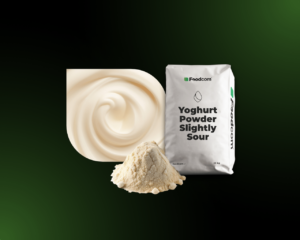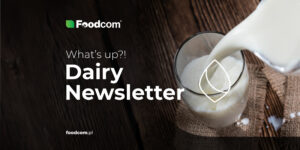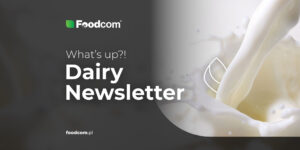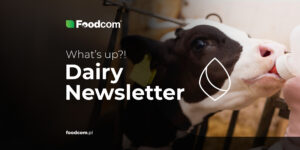- Algeria has contracted 40,000 tonnes of milk powder, setting new CFR price levels.
- Cheese and milk fat prices are under pressure from growing supply and limited exports.
- The Russian dairy sector is growing despite sanctions and falling cow numbers.
- The EU-US dispute over PDOs is intensifying, affecting global dairy trade.
Welcome Partners!
Welcome back to our newsletter!
In the latest edition of our dairy newsletter, we present the latest market trends for milk powder, cheese, fats, liquids and whey products. We also touch on key international issues, including Russia’s export prospects, trade tensions between the EU and the US, innovations in methane reduction and the results of the recent O.N.I.L. tender. Please read through the individual sections to get a full picture of the current dairy market situation.
Milk powder
The market for skimmed milk powder (SMP) for food use has seen a slight correction in prices, falling to 2300-2400 EUR/MT. This is due to increased availability of raw milk and moderate interest from processors.
For SMP for feed purposes, wholesale prices fell to around 2350-2400 EUR/MT (DAP Europe). The market remains cautious and low export activity limits the potential for price increases.
The decision on the long-awaited O.N.I.L tender has just been confirmed. Algeria has secured 20 000 tonnes of SMP at USD 2940-2950 CFR and 20 000 tonnes of WMP at USD 4450-4500 CFR for delivery between July and October. Most of the volume was allocated to European traders. This result confirms Algeria’s strong import demand and sets a benchmark for future international prices.
Cheese
Prices for hard cheeses remain relatively stable, although pressure from increasing milk supply and reduced exports is increasingly being felt.
Gouda and edam cheese prices are at 4250-4350 EUR/MT and 4200-4300 EUR/MT respectively. Domestic demand is keeping the market balanced, despite greater product availability than in previous months.
Cheddar remains under pressure and is currently sold at 4600-4700 EUR/MT EXW. Competitive US cheddar prices and a stronger euro against the dollar are limiting export opportunities for European producers.
The price of mozzarella is 4100-4200 EUR/MT. Rising production and weaker exports mean that larger volumes of this product remain on the EU market.
Fats
The butter market remains influenced by the seasonal increase in milk supply. Butter in blocks is currently trading in the 7150-7300 EUR/MT EXW range. Despite persistently high cream prices, the balance between limited demand and increasing supply is starting to negatively impact the dairy fat market. Market participants are wondering whether the current price level marks the end of the decline or just a short break.
Prices for anhydrous milk fat (AMF) remain stable for the time being, although small adjustments cannot be ruled out in the coming weeks due to changing market fundamentals.
Liquids
Cream prices continue to fall, currently fluctuating between 7800-8000 EUR/MT. Industry demand remains subdued and the high milk supply further reduces pressure on prices.
SMC prices are 1450-1600 EUR/MT (FCA Western European Union), depending on the country of origin and quality of the raw material.
Spot milk prices in Europe remain at an average of 0.40-0.42 EUR/kg, confirming the ongoing seasonal peak and the good quality of the raw material supplied.
Whey powder
Sweet whey powder (SWP) prices for the food industry remain stable at 940-970 EUR/MT, supported by demand from Asia despite competition from the United States.
The feed segment is seeing slight declines, with DAP prices in Europe fluctuating between 840-890 EUR/MT, with lower rates in Q2 contracts.
Whey concentrate, depending on protein and dry matter content, is trading in the 100-400 EUR/MT FCA range. Despite good availability, logistical problems are affecting delivery rates in the EU.
Whey Protein Isolate (WPI) prices in Europe remained relatively stable this week, while Whey Protein Concentrate 80% (WPC80) prices recorded a slight increase, driven by stronger demand in Asian markets. In contrast, prices for both WPI and WPC in the US recorded a slight decline, reflecting weaker dynamics in the domestic and export markets.
News
Asia
Russia’s dairy sector is seeing an increase in production, but faces major challenges. According to Soyuzmoloko, milk production is expected to reach 38.9 million tonnes by 2030, an increase of almost 5 million tonnes compared to 2024. However, the dairy cow population has decreased by 3.2% in 2024, and investment in the sector has declined due to reduced state support and rising credit costs. In addition, sanctions are hampering exports, forcing producers to increase sales on the domestic market, putting pressure on prices. Despite these difficulties, Russia plans to increase dairy exports by 15-20% per year, focusing on markets in North Africa, the Middle East and Southeast Asia, with the hope of balancing the domestic market situation.
Asia
Researchers from MIT and Israeli company Metha AI have developed an artificial intelligence model that predicts with high accuracy the effectiveness of feed additives in reducing methane emissions in dairy cows. In a study conducted on 13 Israeli farms, the use of an essential oil-based additive (Agolin Ruminant) resulted in an average reduction of 9.86% in methane emissions, with 11 farms reporting reductions ranging from 0.1% to 19%. By analysing the rumen microbiome, the AI model enables farmers to fine-tune feeding strategies to the specifics of their herds, which can lead to more efficient production and lower environmental impact.
Europe & North America
The dispute between the US and the EU over protected geographical indications (PGIs) for food products such as ‘feta’ and ‘parmesan’ is escalating again. US dairy organisations, including the National Milk Producers’ Federation (NMPF), accuse the European Union of abusing the PGI system, which they claim limits US producers’ access to key export markets and exacerbates the trade deficit in the dairy sector. In response, the European Dairy Association (EDA) stresses that the EU’s quality policy is aimed at protecting cultural heritage and supporting local communities, not eliminating competition. The dispute has important implications for future US-EU trade negotiations and for dairy producers around the world who need to adapt to changing regulations on product names.
![Stable trends, seasonal pressures and changes in the global dairy market [266th Edition of DAIRY Newsletter] Stable trends, seasonal pressures and changes in the global dairy market [266th Edition of DAIRY Newsletter]](https://foodcom.pl/wp-content/uploads/2023/08/Foodcom_Newsletter_Dairy-1520x760.jpg)






